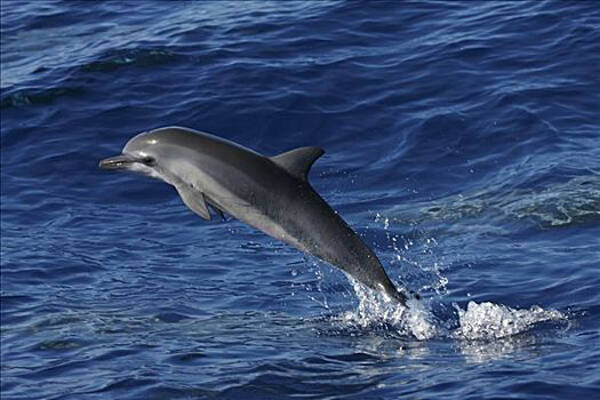Stenella longirostris
IUCN
LCBasic Information
Scientific classification
- name:Stenella longirostris
- Scientific Name:Spinner dolphin, spinner dolphin, long-beaked spinner dolphin
- Outline:Cetacea
- Family:Delphinidae Delphinidae
Vital signs
- length:1.29-2.35m
- Weight:80-150kg
- lifetime:30-40years
Feature
The snout is slender and accounts for 8.1% to 9.9% of the body length, the longest among the genus Prodolphins.
Distribution and Habitat
It is distributed in tropical and subtropical waters of the northern and southern hemispheres, ranging roughly between 40 degrees north latitude and 40 degrees south latitude.
Origin (sea area): American Samoa, Anguilla, Argentina, Aruba, Australia, Bahamas, Bahrain, Bangladesh, Belize, Bermuda, Brazil, British Indian Ocean Territory, Brunei Darussalam, Cambodia, Cape Verde, Cayman Islands, China, Cocos Island, Colombia, Comoros, Cook Islands, Costa Rica, Côte d'Ivoire, Cuba, Djibouti, Dominica, Dominican Republic, Ecuador (Galapagos Islands), Egypt, El Salvador, Fiji, French Polynesia, Ghana, Guam, Guatemala, Honduras, Guinea, Hong Kong, India, Indonesia, Iran, Jamaica, Japan (Honshu), Kenya, Kiribati, Liberia, Madagascar, Malaysia, Maldives, Marshall Islands, Martinique, Mauritania , Mexico, Micronesia, Mozambique, Myanmar, Netherlands Antilles, New Caledonia, Nicaragua, Niue, Northern Mariana Islands, Oman, Pakistan, Panama, Papua New Guinea, Peru, Philippines, Puerto Rico,
Appearance
The beak is long and narrow. The body is slender with three color spots on the upper, middle and lower parts. The dorsal fin is nearly triangular. The palatine groove of the skull is very shallow.
The adult body length is 1.29~2.35 meters, and the male is slightly larger than the female. The long-beaked dolphin is slender, with a long and thin beak and a narrow head at the apex of the melanops. The dorsal fin is basically triangular, but there are various variations, from a slightly sickle-shaped right triangle to an upright isosceles triangle. In adult males of local populations in the Americas, the dorsal fin can be tilted forward so that it looks like swimming backwards. In connection with this, these individuals have an enlarged post-anal ridge on the ventral side of the caudal peduncle. The dorsal fin of juveniles and young dolphins is more sickle-shaped.
In most areas, individuals have three color spots on the upper, middle and lower parts, that is, dark gray cape, light gr
Details
Long-beaked dolphin (scientific name: Stenella longirostris) is also known as Spinner Dolphin in English. There are 4 subspecies.

There are about 118 long-beaked dolphins in the northern Mozambique Channel surrounding Mayotte Island. They often travel in groups of more than 200, and large groups of 1,000 have also been found. They are highly sociable and are good at traveling with other aquarium/52-marine-animals.html">marine animals or their own kind. Known partners include: spotted dolphins, yellowfin tuna, and bonito. Long-beaked dolphins usually hibernate in shallow waters near bays. After waking up, they swim into the deep sea to prey on fish that migrate vertically in the water layer. In the deep and dark underwater, they are also vulnerable to attacks by natural enemies. There is a hierarchical sequence in this type of dolphin group, which is arranged in descending order of threat level and involves the closeness of the relationship. The so-called "threat" generally refers to a simple light bump or abrupt gesture. In closed waters far away from the high seas, the hierarchical order of the dolphin group can play a role.
The long-beaked dolphin is carnivorous and mainly feeds on pelagic fish, shrimp and squid. Most of its prey are vertically migrating species.

When the hormone levels of long-beaked dolphins are high, they begin to mate, 1 to 2 times a year. Males enter the reproductive period at 10 to 12 years old, and females enter the reproductive period at 5.5 to 10 years old. Adult female dolphins give birth to one calf every 2 to 3 years. The average gestation period is 10.6 months, and the average body length of newborn calves is 75 to 80 cm. The females nurse their young for at least seven months. The largest population of long-beaked dolphins is found in the tropical waters of the eastern Pacific Ocean, where 613,000 were counted in 2003, up from 428,000 in 2000; between 1979 and 2000, annual population counts ranged from 271,000 to 734,000. Long-beaked dolphins are the most abundant species in the western-central Pacific Ocean, with 3,351 individuals counted in 2002 by line transects throughout the Hawaiian Islands. In the summer of 2006, a survey of the coastal waters of the Manu'a Islands, Ross Atoll, Swains Island, and Samoa estimated 34 groups of 46 long-beaked dolphins, making them the most abundant cetacean population in the region. They are also the species with the highest abundance in Philippine waters, with 31,512 in the East Sulu Sea and 3,489 in the Tanon Strait. In the Mergui Archipelago in southern Myanmar, the long-beaked dolphin is the third most frequent species. In the northern Gulf of Mexico, the average abundance of its population was 1,989 in 2003-2004.
Listed in Appendix II of the Convention on the Conservation of Migratory Species of Wild Animals (CMS).
Listed in Appendix II of the Convention on International Trade in Endangered Species of Wild Fauna and Flora (CITES).
Listed in the "National Key Protected Wildlife List": National Class II Protected Animals (effective December 10, 1988, all species of the family Delphinidae).
Listed in the "IUCN Red List of Endangered Species": Data Deficient (DD), assessed in 2008.
Protect wildlife and eliminate game.
Maintaining ecological balance is everyone's responsibility!








